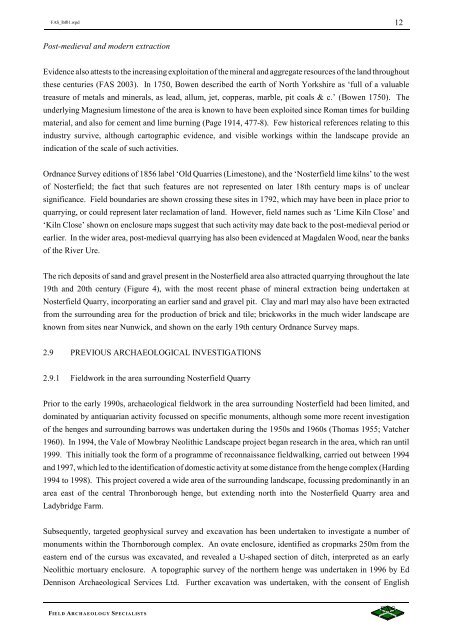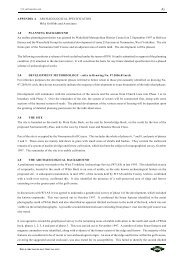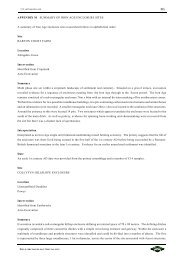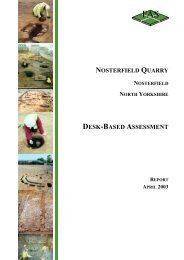ARCHAEOLOGICAL EVALUATION - Mike Griffiths and Associates
ARCHAEOLOGICAL EVALUATION - Mike Griffiths and Associates
ARCHAEOLOGICAL EVALUATION - Mike Griffiths and Associates
You also want an ePaper? Increase the reach of your titles
YUMPU automatically turns print PDFs into web optimized ePapers that Google loves.
FAS_lbf01.wpd 12<br />
Post-medieval <strong>and</strong> modern extraction<br />
Evidence also attests to the increasing exploitation of the mineral <strong>and</strong> aggregate resources of the l<strong>and</strong> throughout<br />
these centuries (FAS 2003). In 1750, Bowen described the earth of North Yorkshire as ‘full of a valuable<br />
treasure of metals <strong>and</strong> minerals, as lead, allum, jet, copperas, marble, pit coals & c.’ (Bowen 1750). The<br />
underlying Magnesium limestone of the area is known to have been exploited since Roman times for building<br />
material, <strong>and</strong> also for cement <strong>and</strong> lime burning (Page 1914, 477-8). Few historical references relating to this<br />
industry survive, although cartographic evidence, <strong>and</strong> visible workings within the l<strong>and</strong>scape provide an<br />
indication of the scale of such activities.<br />
Ordnance Survey editions of 1856 label ‘Old Quarries (Limestone), <strong>and</strong> the ‘Nosterfield lime kilns’ to the west<br />
of Nosterfield; the fact that such features are not represented on later 18th century maps is of unclear<br />
significance. Field boundaries are shown crossing these sites in 1792, which may have been in place prior to<br />
quarrying, or could represent later reclamation of l<strong>and</strong>. However, field names such as ‘Lime Kiln Close’ <strong>and</strong><br />
‘Kiln Close’ shown on enclosure maps suggest that such activity may date back to the post-medieval period or<br />
earlier. In the wider area, post-medieval quarrying has also been evidenced at Magdalen Wood, near the banks<br />
of the River Ure.<br />
The rich deposits of s<strong>and</strong> <strong>and</strong> gravel present in the Nosterfield area also attracted quarrying throughout the late<br />
19th <strong>and</strong> 20th century (Figure 4), with the most recent phase of mineral extraction being undertaken at<br />
Nosterfield Quarry, incorporating an earlier s<strong>and</strong> <strong>and</strong> gravel pit. Clay <strong>and</strong> marl may also have been extracted<br />
from the surrounding area for the production of brick <strong>and</strong> tile; brickworks in the much wider l<strong>and</strong>scape are<br />
known from sites near Nunwick, <strong>and</strong> shown on the early 19th century Ordnance Survey maps.<br />
2.9 PREVIOUS <strong>ARCHAEOLOGICAL</strong> INVESTIGATIONS<br />
2.9.1 Fieldwork in the area surrounding Nosterfield Quarry<br />
Prior to the early 1990s, archaeological fieldwork in the area surrounding Nosterfield had been limited, <strong>and</strong><br />
dominated by antiquarian activity focussed on specific monuments, although some more recent investigation<br />
of the henges <strong>and</strong> surrounding barrows was undertaken during the 1950s <strong>and</strong> 1960s (Thomas 1955; Vatcher<br />
1960). In 1994, the Vale of Mowbray Neolithic L<strong>and</strong>scape project began research in the area, which ran until<br />
1999. This initially took the form of a programme of reconnaissance fieldwalking, carried out between 1994<br />
<strong>and</strong> 1997, which led to the identification of domestic activity at some distance from the henge complex (Harding<br />
1994 to 1998). This project covered a wide area of the surrounding l<strong>and</strong>scape, focussing predominantly in an<br />
area east of the central Thronborough henge, but extending north into the Nosterfield Quarry area <strong>and</strong><br />
Ladybridge Farm.<br />
Subsequently, targeted geophysical survey <strong>and</strong> excavation has been undertaken to investigate a number of<br />
monuments within the Thornborough complex. An ovate enclosure, identified as cropmarks 250m from the<br />
eastern end of the cursus was excavated, <strong>and</strong> revealed a U-shaped section of ditch, interpreted as an early<br />
Neolithic mortuary enclosure. A topographic survey of the northern henge was undertaken in 1996 by Ed<br />
Dennison Archaeological Services Ltd. Further excavation was undertaken, with the consent of English<br />
FIELD ARCHAEOLOGY SPECIALISTS







